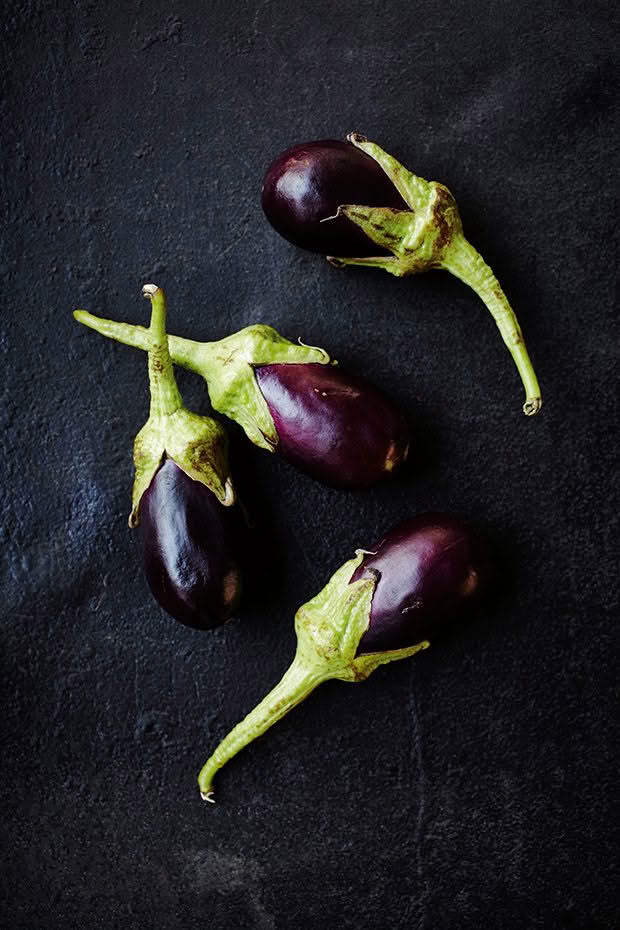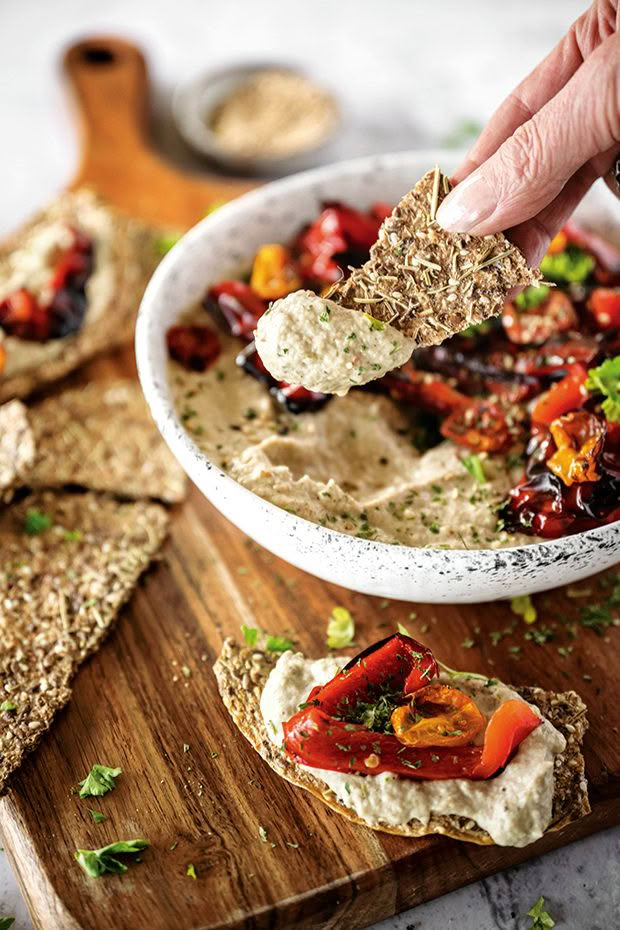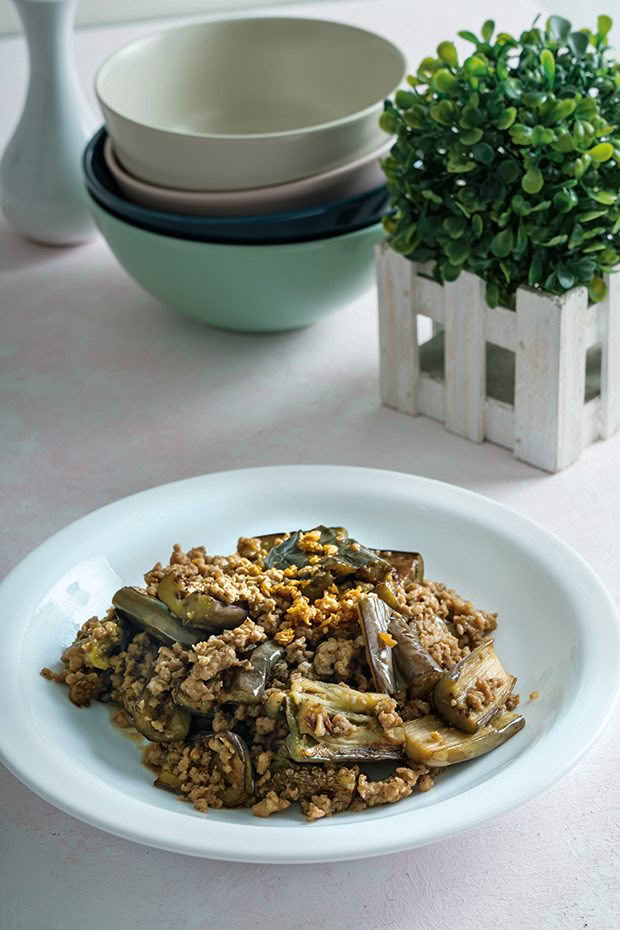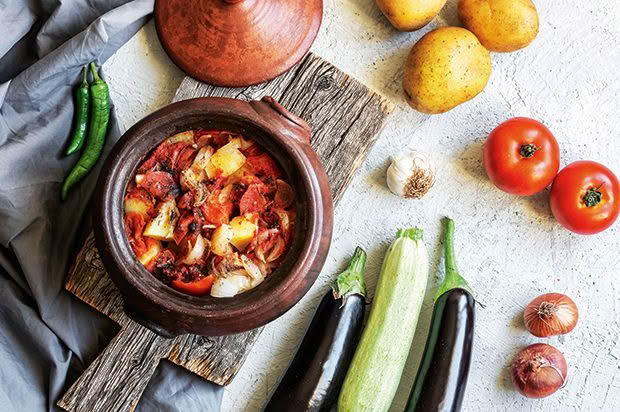How to make the most of an eggplant haul

Nothing absorbs flavours like eggplant. Jenny Garing shares her tips to get the best out of this peculiar purple vegetable.
Words: Jenny Garing
It goes by many names. In France and the UK they call it aubergine. In North America and the antipodes they call it eggplant. In its native India it’s called brinjal, in West Africa it’s a garden egg and in the Caribbean it’s known as a “brown jolly” (surely the best name). In Italian the name is melanzana or “apple of madness”, as it was initially suspected of being poisonous. But no matter what you call it, eggplant (Solanum melongena) is surely one of the earth’s most versatile and fascinating vegetables.
Although the name eggplant is often considered synonymous with the oval, purple fruit commonly seen in supermarkets, there are many different varieties and cultivars across the world that produce different coloured and shaped fruit. There’s the small, golf ball-sized Thai eggplant, and there’s the long, thin, lavender-coloured Japanese type. The name “eggplant” actually comes from a small, egg-shaped variety that was the first to reach Europe from India.
Many people claim they do not like the taste of eggplant, but I think this is probably because they haven’t eaten the vegetable when it’s been prepared properly. To enjoy eggplant, you must, absolutely and unconditionally, cook it thoroughly. Serving someone a dish with undercooked, tough and rubbery eggplant is akin to serving a raw potato. Fortunately, eggplant responds well to most cooking methods including roasting, barbecuing, char-grilling, frying and even microwaving.
One of the best culinary qualities of the eggplant is its ability to absorb oils and flavours from other ingredients. It combines exceptionally well with garlic, smoked paprika, cumin, cinnamon, chilli, capsicum, tomato, lemon, soya sauce, miso, tahini, sesame seeds, yoghurt, dill, mint, parsley and thyme. You can try a wonderfully simple salad consisting of fried or barbecuing slices of eggplant mixed with fresh mint and ground cumin, with a tangy yoghurt dressing. While I don’t think it’s necessary to always salt eggplant when cooking, it’s a great way to prevent it absorbing too much oil, especially while frying.

One of the best ways to prepare eggplant is to char it whole over a naked flame, either on your BBQ or over a gas stove top. This turns it into a silky, smoky flavour bomb that you can use to make baba ganoush by adding tahini, garlic, lemon juice and olive oil. Try adding your barbecued eggplant flesh to a lentil soup or use as a puree base for grilled lamb or beef.
If you are baking a whole eggplant in the oven to extract its soft pulpy flesh, always stab small holes in it first to reduce the risk of an explosion. You can stuff eggplant halves with minced meat or rice with a tomato passata and bake them. In the Ukrainian dish known as poor man’s caviar (“ikra”), whole roasted eggplant is skinned and chopped up with roast capsicums, and mixed with finely diced fresh tomatoes, raw garlic, parsley, raw onion, vinegar, and olive oil. This is served across Eastern Europe as an appetiser with bread.
I’m usually not a fan of using a microwave to cook food. But cooking a whole eggplant in the microwave does make for a soft end result without the need for soggy oil. Prick the whole eggplant, pop it in a bowl, cover with cling film and microwave for about 10 minutes. It can then be chopped up or sliced for use as a pizza topping, in a pasta dish, or my favourite – fingers of eggplant covered in a warm dressing of chilli, sesame oil, garlic, chopped spring onions and sesame seeds.
Traditional eggplant dishes are found all over the world. Do as the Japanese do and grill long slices with a smear of miso or create a classic French ratatouille nightshade combo of eggplant chunks, courgettes, capsicums, onion, garlic and tomatoes all stewed together with some basil, rosemary or thyme. A great idea is to harness some inspiration from the traditional home of eggplant – Asia – and use it in a Vietnamese pork hotpot.
Vietnamese Pork and Eggplant Hotpot

This dish is common in northern Vietnam, especially in the cooler months. It is traditionally cooked in clay pots and brought to the table sizzling. The complex layers of flavour make this dish incredibly appetising. It is our go-to mid-week dish at home when our palates are jaded. As is often the case in Vietnamese dishes, there’s a perfect balance between the flavours: the aromatic heat from chilli and pepper, the underlying sweetness from the caramelised sugar and onions, the saltiness from the fish sauce and the sourness from the lime juice.
Prep Time: 10 minutes
Cook time: 1 hour
Serves: 4-5
INGREDIENTS
2 eggplants, cut into 1½ inch chunks
5 tbsp vegetable oil
2 onions, chopped
1 tbsp palm sugar
2 red chillies, seeded and chopped
3 garlic cloves, finely chopped
4 coriander roots, chopped (if not available, use stems)
1½ inch piece of fresh ginger, peeled and crushed
500g pork mince
1 cinnamon stick (broken into 2)
3 star anise
3 tbsp fish sauce
juice of 2 limes
handful chopped coriander
salt and black pepper to taste
METHOD
Heat a tablespoon of the oil in a frying pan on medium and add the eggplant chunks in batches, frying until they’re golden brown on all sides – adding more oil if the eggplant absorbs it all. Remove from the pan and place on a paper towel to drain. Add a splash of oil to your clay pot (or dutch oven), along with the onions and palm sugar. Cook over medium-high heat for 4-5 minutes until the onions begin to caramelise. Season with salt and pepper. Push the onions to one side of the pot and add the chillies, garlic, coriander roots and ginger, cooking for a further two minutes, then stir the mixture into the onions. Add the pork, cinnamon, star anise, fish sauce and some black pepper. Mix in the eggplant and just enough water to cover. Bring to a simmer and then place in the oven. Bake for 40 minutes, checking a couple of times that the liquid hasn’t evaporated. When the meat is cooked and the water absorbed, remove from the oven and stir in the lime juice and coriander. Serve garnished with more coriander.
Pinar’s Eggplant Dish

We visited the best produce market I had ever been to in the dry arid region of Nevşehir, in Central Turkey. The eggplants, capsicums, tomatoes, chillis and cabbages were all huge and beautiful. We wished we had stayed in accommodation with a kitchen, rather than the lovely small hotel we had chosen, so that we could take all this produce home to experiment with. When we returned to the hotel, Pinar, the manager, was making a beautiful vegetable dish for her lunch with produce from the market. She insisted we try it as we passed by. We did, and we knew we had to get the recipe. Like many Turkish dishes, it is the combination of very simple ingredients, cooked simply, but combined perfectly, that creates something much, much greater than its parts. This dish can be eaten by itself or served with meat. It is usually served warm or at room temperature.
Prep time: 10 minute
Cook time: 25 minutes
Serves: 4
INGREDIENTS
2 potatoes (or ½ 500gm packet of frozen shoestring fries)
2 medium sized eggplant, sliced
2 green capsicums, cut into rough chunks
4 tomatoes, quartered
2 cloves garlic, sliced
1 cup of flat leaf parsley
extra virgin olive oil
pinch of salt and pepper
Turkish garlic yoghurt sauce:
½ cup thick yoghurt
1 clove garlic
¼ tsp salt
Spiced butter:
2 tbsp butter
½ tsp chilli flakes (or spicy paprika)
½ tsp dried mint
METHOD
To make the yoghurt sauce, put the garlic and salt into a mortar and pestle and mash together. Add the yoghurt and stir. Leave to sit for the flavours to meld. Slice the eggplants into pieces about ¼ inch thick. Fry them in generous amounts of oil until they are golden brown. Drain on paper towels and set aside in a warm oven. Cut the potatoes into shoestring chips (or cheat and use a bought packet like Pinar did). Fry them in a generous amount of oil until golden. Place them in the oven with the eggplant slices. Add a little oil to the pan and cook the capsicum and garlic on medium heat.
As soon as they are fragrant add the tomatoes. Toss gently until the tomatoes soften, then take the pan off the heat and mix in the chopped parsley.
To serve, place the chips on the serving plate. Top them with the slices of eggplant, then finish with the capsicum/tomato/parsley mixture. Drizzle with the yoghurt sauce. Just before serving, melt the butter in a saucepan until it begins to foam. Add the chilli flakes and dried mint and stir. Immediately drizzle it over the dish, and enjoy!
Love this story? Subscribe now!
 This article first appeared in NZ Lifestyle Block Magazine.
This article first appeared in NZ Lifestyle Block Magazine.
